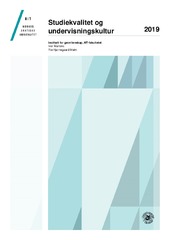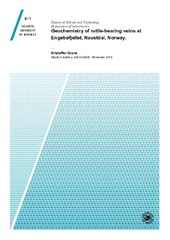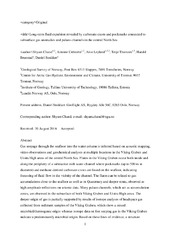Institutt for geovitenskap: Nye registreringer
Viser treff 581-600 av 1121
-
Baseline undersøkelse av studiekvalitet og undervisningskultur på Institutt for geovitenskap ved UiT Norges arktiske universitet
(Research report; Forskningsrapport, 2019-04)Institutt for geovitenskap ved UiT Norges arktiske universitet ønsker å gjøre en innsats for å forbedre undervisningen ved instituttet. Instituttet tilbyr utdanninger på bachelor-, master- og doktorgradsnivå, med 12 bachelorkurs, 28 masterkurs og 9 kurs på doktorgradsnivå. Dette prosjektet fokuserer på undervisningskvaliteten på bachelor- og master utdanningen. Vi håper rapporten kan bidra til ... -
Late Weichselian and Holocene palaeoceanography of Storfjordrenna, southern Svalbard
(Journal article; Tidsskriftartikkel; Peer reviewed, 2015-03-27)Multiproxy analyses (including benthic and planktonic foraminifera, δ<sup>18</sup>O and δ<sup>13</sup>C records, grain-size distribution, ice-rafted debris, XRF geochemistry and magnetic susceptibility) were performed on a <sup>14</sup>C-dated marine sediment core from Storfjordrenna, located off of southern Svalbard. The sediments in the core cover the termination of Bølling–Allerød, the Younger ... -
Exploring the teaching environment in a higher education geoscience programme
(Journal article; Tidsskriftartikkel; Peer reviewed, 2019-03-19)This paper explores the teaching environment among the teaching staff in thegeoscience programme at UiT The Arctic University of Norway. The findings in this paper are based on a large baseline study conducted in 2018. This paper operationalises the teaching culture by analysing the teachers’ ideas, collaborations, and attitudes towards teaching. In-depth interviews ... -
Geochemistry of rutile-bearing veins at Engebøfjellet, Naustdal, Norway.
(Master thesis; Mastergradsoppgave, 2018-11-15)The Engebøfjellet eclogite, located in Naustdal, Norway, contain quartz veins with large rutile (TiO2) phenocrystals. Trace element composition of rutile deposited in veins and in the eclogite matrix was analysed with the use of LA-ICP-MS. The Nb content decrease with increasing V in the rutile, and contents of these elements vary depending on depositional environment. One quartz vein associated ... -
Image based quantitative comparisons indicate heightened megabenthos diversity and abundance at a site of weak hydrocarbon seepage in the southwestern Barents Sea
(Journal article; Tidsskriftartikkel; Peer reviewed, 2019-08-08)<p><i>Background - </i>High primary productivity in the midst of high toxicity defines hydrocarbon seeps; this feature usually results in significantly higher biomass, but in lower diversity communities at seeps rather than in the surrounding non-seep benthos. Qualitative estimates indicate that this dichotomy does not necessarily hold true in high latitude regions with respect to megafauna. Instead, ... -
Petroleum, coal and research drilling onshore Svalbard: a historical perspective
(Journal article; Tidsskriftartikkel; Peer reviewed, 2019-07-05)The beginning of the Norwegian oil industry is often attributed to the first exploration drilling in the North Sea in 1966, the first discovery in 1967 and the discovery of the supergiant Ekofisk field in 1969. However, petroleum exploration already started onshore Svalbard in 1960 with three mapping groups from Caltex and exploration efforts by the Dutch company Bataaffse (Shell) and the Norwegian ... -
Sedimentology and palynology of the Lower Cretaceous succession of central Spitsbergen: integration of subsurface and outcrop data
(Journal article; Tidsskriftartikkel; Peer reviewed, 2019-06-27)The Lower Cretaceous succession in Svalbard is commonly considered as an important analogue to age-equivalent strata on the Barents Shelf which are sporadically targeted by exploration wells. In this study, the stratigraphic and genetic relationship between the Rurikfjellet (open marine), Helvetiafjellet (paralic) and Carolinefjellet (open marine) formations of the Lower Cretaceous succession in ... -
Significance of substrate soil moisture content for rockfall hazard assessment
(Journal article; Tidsskriftartikkel; Peer reviewed, 2019-05-27)Rockfall modelling is an important tool for hazard analysis in steep terrain. Calibrating terrain parameters ensures that the model results more accurately represent the site-specific hazard. Parameterizing rockfall models is challenging because rockfall runout is highly sensitive to initial conditions, rock shape, size and material properties, terrain morphology, and terrain material properties. ... -
Conduit processes during the February 11, 2010 Vulcanian eruption of Soufriere Hills, Montserrat
(Journal article; Tidsskriftartikkel; Peer reviewed, 2019-01-29)We analyzed pumice from the February 11, 2010 Vulcanian explosion that immediately followed a large dome collapse at Soufrière Hills volcano. We obtained pre-explosive values of porosity, pressure, and depth by combining textural analyses and glass water content determinations. Our data suggest that the February 2010 explosion evacuated the upper 3 km of the conduit from the dense magma (≤10 vol% ... -
A High-Resolution Geomagnetic Relative Paleointensity Record From the Arctic Ocean Deep-Water Gateway Deposits During the Last 60 kyr
(Journal article; Tidsskriftartikkel; Peer reviewed, 2019-04-16)We present a paleomagnetic and rock magnetic data set from two long sediment cores collected from Bellsund and Isfjorden contourite drifts located on the eastern side of the Fram Strait (western Spitsbergen margin). The data set gave the opportunity to define the behavior of the past geomagnetic field at high latitude and to constrain the palaeoclimatic events that occurred in a time framework ... -
Cenozoic Erosion of the Barents Sea Shelf, Norwegian Arctic: A Review
(Conference object; Konferansebidrag, 2018-12)The circum North Atlantic-Arctic continental margin and adjacent land areas have experienced several episodes of uplift and erosion during the Cenozoic. A series of efforts quantifying this erosion for the Barents Sea shelf, where the Arctic shelf is at its widest and deepest have been done since the early 90’s using different methods. As the seismic and well database have expanded considerably, ... -
Chemosynthesis influences food web and community structure in high-Arctic benthos
(Journal article; Tidsskriftartikkel; Peer reviewed, 2019-10-25)Cold seeps are locations where seafloor communities are influenced by the seepage of methane and other reduced compounds from the seabed. We examined macro-infaunal benthos through community analysis and trophic structure using stable isotope analysis at 3 seep locations in the Barents Sea. These seeps were characterized by high densities of the chemosymbiotic polychaetes Siboglinidae, clade Frenulata ... -
Meter-Scale 3D Seismic Data for High-Resolution Site Characterization
(Conference object; Konferansebidrag, 2019-06-03)High-resolution 3D site characterization can deliver reliable quantitative property volumes of the subsurface when based on seismic data able to image meter-sized objects. Following the theoretical analysis of seismic wave propagation in the shallow sub-surface, we present case studies based on re-processing of 3D P-Cable seismic data. The case study of data re-processing from the Vestnesa Ridge ... -
Devonian core complex exhumation and Cenozoic decollements as alternatives to the Ellesmerian Orogeny
(Conference object; Konferansebidrag, 2018-10)The Ellesmerian Orogeny (Piepjohn et al., 2000) is a short-lived contractional–transpressional event that occurred in the Late Devonian–Mississippian, i.e., after Devonian collapse of the Caledonides and prior to Carboniferous rifting. Thus far, this episode of contraction–transpression was required to explain the presence of undeformed Carboniferous–Permian sedimentary rocks on top of folded ... -
WNW-ESE-striking Timanian faults in Svalbard
(Conference object; Konferansebidrag, 2019-10) -
Mississippian rocks and WNW–ESE-striking faults in Spitsbergen
(Conference object; Konferansebidrag, 2019-06-18) -
Impact of Timanian thrusts on the Phanerozoic tectonic history of Svalbard
(Conference object; Konferansebidrag, 2019-09-13)Despite more than a century of investigation, the relationship between basement rocks throughout the Svalbard Archipelago is still a mystery. Though these rocks display similar geochronological ages, they show significantly different metamorphic grades and structures. Thus far, Svalbard was believed to be composed of three terranes of rocks formed hundreds–thousands of kilometers apart and accreted ... -
Dissolved Inorganic Geogenic Phosphorus Load to a Groundwater-Fed Lake: Implications of Terrestrial Phosphorus Cycling by Groundwater
(Journal article; Tidsskriftartikkel; Peer reviewed, 2019-10-24)The general perception has long been that lake eutrophication is driven by anthropogenic sources of phosphorus (P) and that P is immobile in the subsurface and in aquifers. Combined investigation of the current water and P budgets of a 70 ha lake (Nørresø, Fyn, Denmark) in a clayey till-dominated landscape and of the lake’s Holocene trophic history demonstrates a potential significance of geogenic ... -
Long-term fluid expulsion revealed by carbonate crusts and pockmarks connected to subsurface gas anomalies and palaeo-channels in the central North Sea
(Journal article; Tidsskriftartikkel; Peer reviewed, 2016-11-19)Gas seepage through the seafloor into the water column is inferred based on acoustic mapping, video observations and geochemical analyses at multiple locations in the Viking Graben and Utsira High areas of the central North Sea. Flares in the Viking Graben occur both inside and along the periphery of a submarine melt water channel where pockmarks (up to 500 m in diameter) and methane-derived carbonate ... -
Changes in sea ice cover and ice sheet extent at the Yermak Plateau during the last 160 ka - Reconstructions from biomarker records
(Journal article; Tidsskriftartikkel; Peer reviewed, 2018-02-15)The Yermak Plateau is located north of Svalbard at the entrance to the Arctic Ocean, i.e. in an area highly sensitive to climate change. A multi proxy approach was carried out on Core PS92/039-2 to study glacial-interglacial environmental changes at the northern Barents Sea margin during the last 160 ka. The main emphasis was on the reconstruction of sea ice cover, based on the sea ice proxy ...


 English
English norsk
norsk


















